Infratemporal fossa
Question 1. Define infratemporal fossa and enumerate its boundaries and contents.
Answer.
The infratemporal fossa is a large irregular space beneath the zygomatic arch between side wall of pharynx and ramus of mandible.
Infratemporal Fossa Boundaries
Anterior: Posterior (infratemporal) surface of the body of maxilla.
Posterior: Styloid process.
Medial: Lateral pterygoid plate and pyramidal process of palatine bone.
Lateral: Ramus of mandible.
Roof: Infratemporal surface of the greater wing of sphenoid.
Floor: Open and extends up to the base of mandible.
Infratemporal Fossa Contents
Two muscles: Lateral and medial pterygoids. (Note: In addition to these muscles, the tendon of temporalis muscle also lies in this fossa.)
Two nerves: Mandibular and chorda tympani.
One artery: Maxillary artery.
Two venous structures: Pterygoid venous plexus and maxillary vein.
One ganglion: Otic ganglion.
Question 2. Enumerate the muscles of mastication.
Answer.
- Chief muscles of mastication
- Masseter (most superficial)
- Temporalis
- Lateral pterygoid
- Medial pterygoid
- Accessory muscles of mastication
-
- Buccinator muscle
- Digastric muscle
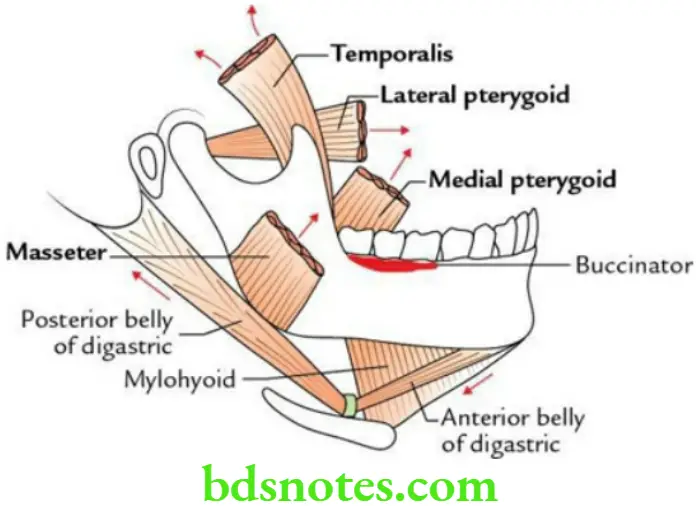
Question 3. Discuss the origin, insertion, nerve supply and action of masseter muscle.
Answer.
Masseter Muscle Origin
Superficial part: From the anterior two-third of the lower border of zygomatic arch and adjoining part of zygomatic process of maxilla.
Deep part: From the inner surface of zygomatic arch.
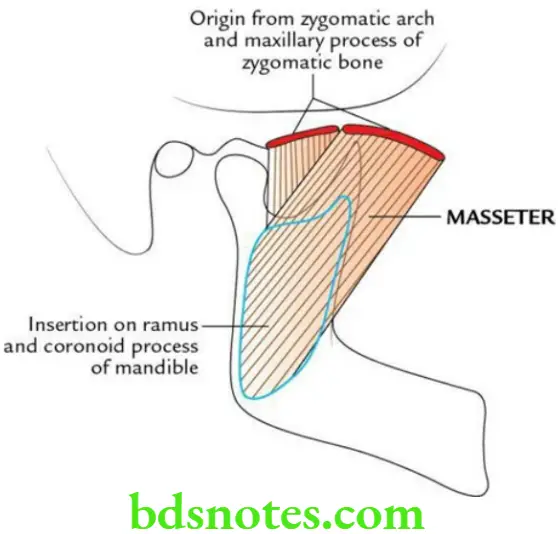
Masseter Muscle Insertion
Into the outer surface of the ramus of mandible.
Masseter Muscle Nerve supply
Masseteric nerve from the anterior division of the mandibular nerve.
Masseter Muscle Action
Elevation of mandible to close the mouth (as required during biting).
Question 4. Discuss the origin, insertion nerve supply and actions of temporalis muscle.
Answer.
Temporalis Muscle Origin
From the floor of temporal fossa and deep surface of temporal fascia.
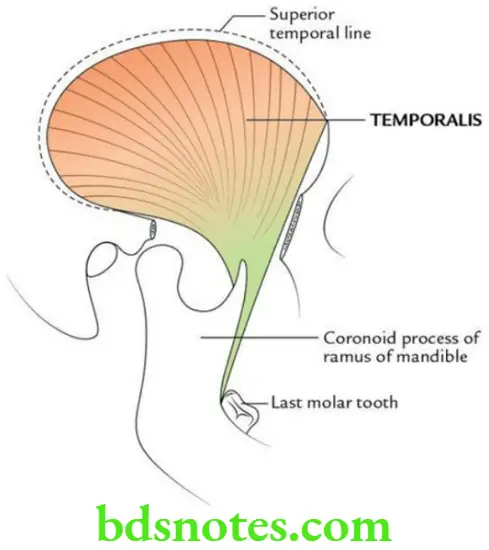
Temporalis Muscle Insertion
Into the coronoid process (tip, inner surface and anterior border) of the ramus of mandible.
Temporalis Muscle Nerve supply
Two deep temporal nerves from the anterior division of the mandibular nerve.
Read And Learn More: Selective Anatomy Notes And Question And Answers
Temporalis Muscle Actions
- Elevation of mandible
- Retraction of mandible
- Helps in side-to-side movement of the lower jaw during grinding
Question 5. Discuss the origin, insertion, nerve supply and actions of lateral pterygoid muscle.
Answer.
The lateral pterygoid is the key muscle of infratemporal region.
Lateral Pterygoid Muscle Origin
By two heads:
- Upper smaller head arises from the infratemporal crest and infratemporal surface of the greater wing of the sphenoid.
- Lower larger head arises from the lateral surface of the lateral pterygoid plate.
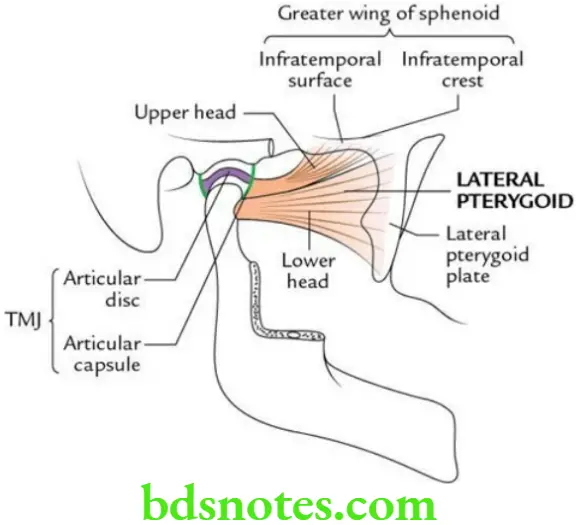
Lateral Pterygoid Muscle Insertion
Into the pterygoid fovea present on the front of the neck of mandible. Some fibres are also inserted into the articular disc and capsule of the temporomandibular joint.
Lateral Pterygoid Muscle Nerve supply
A branch from the anterior division of the mandibular nerve.
Lateral Pterygoid Muscle Actions
- Depression of mandible to open the mouth; while doing so, muscle pulls the articular disc forwards.
- Protrusion of mandible.
- Along with ipsilateral medial pterygoid muscle, it pushes the chin to the opposite side.
Question 6. Discuss the origin, insertion, nerve supply and actions of medial pterygoid muscle.
Answer.
Medial Pterygoid Muscle Origin
By two heads:
- Smaller superficial head arises from the tuberosity of maxilla.
- Larger deep head from the medial surface of the lateral pterygoid plate.
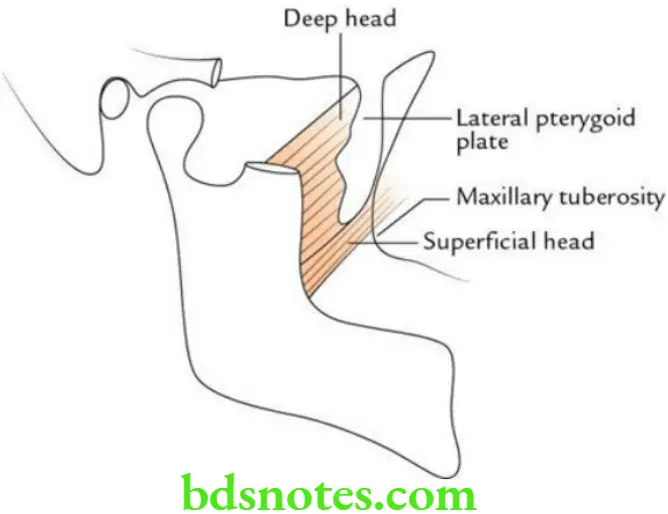
Medial Pterygoid Muscle Insertion
Into the medial surface of the ramus of mandible, above the angle of mandible and below the mandibular foramen.
Medial Pterygoid Muscle Nerve supply
Nerve to medial pterygoid, a branch from main trunk of the mandibular nerve.
Medial Pterygoid Muscle Actions
- Elevation of mandible
- Helps in protrusion of mandible
- Along with ipsilateral, lateral pterygoid pushes the chin to opposite side
Question 7. Why lateral pterygoid muscle is regarded as the key muscle of the infratemporal region? List its relations.
Answer.
The lateral pterygoid muscle is regarded as the key muscle of the infratemporal region because its relations provide the fair idea of the layout of the structures in the infratemporal fossa.
Lateral Pterygoid Muscle Relations
Superficial relations
- Masseter
- Ramus of mandible
- Tendon of temporalis
- Maxillary artery
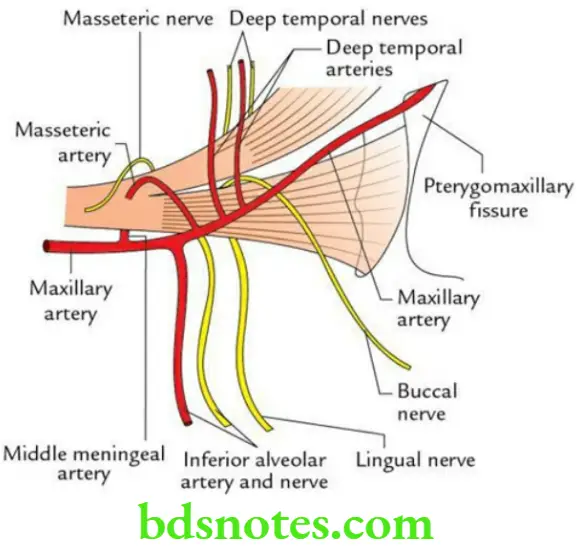
Lateral Pterygoid Muscle Deep relations
- Mandibular nerve
- Middle meningeal artery
- Sphenomandibular ligament
- Deep head of medial pterygoid
Lateral Pterygoid Muscle Structures emerging from the upper border
- Deep temporal nerves
- Masseteric nerve
Lateral Pterygoid Muscle Structures emerging from its lower border
- Lingual nerve
- Inferior alveolar nerve
- Middle meningeal artery (in fact passes upward deep to muscle)
Lateral Pterygoid Muscle Structures passing between two heads
- Maxillary artery (enters)
- Buccal branch of mandibular nerve (comes out)
Question 8. Describe the mandibular nerve under the following headings: (a) origin, (b) course, (c) branches and (d) distribution.
Answer.
Mandibular Nerve Origin and course
The mandibular nerve is the largest division of trigeminal nerve. It arises from the trigeminal ganglion and enters the infratemporal fossa through foramen ovale. In the foramen ovale, it is joined by the small motor root of the trigeminal nerve, and thus emerges from the skull as a mixed nerve. After emerging from foramen ovale, it divides almost immediately into the anterior and posterior divisions.
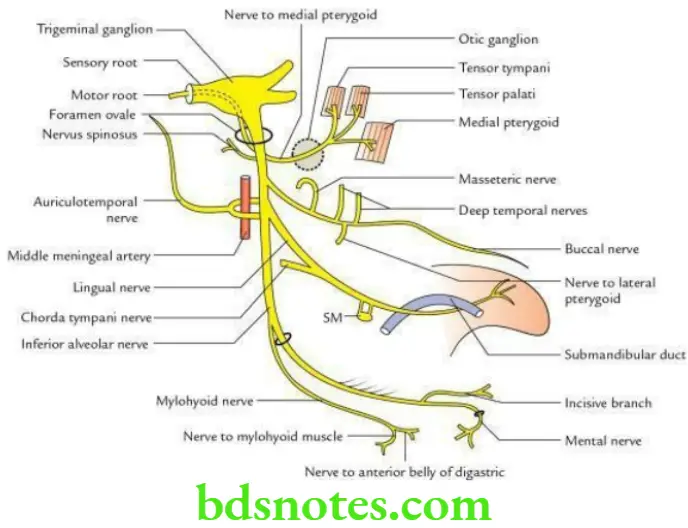
Mandibular Nerve Branches and distribution
From the trunk
- Meningeal branch (nervus spinosus), which enters the skull through foramen spinosum and supplies the dura mater.
- Nerve to medial pterygoid, it passes through otic ganglion and supplies the medial pterygoid muscle. In addition to it, it also supplies twigs to the tensor palati and tensor tympani muscles.
From the anterior division
- Muscular branches to the temporalis (deep temporal nerves), masseter (masseteric nerve) and nerve to the lateral pterygoid.
- Buccal nerve (sensory to the skin and mucosa of the cheek).
From the posterior division
- Auriculotemporal nerve (sensory to the auricle and temple).
- Lingual nerve (sensory to the anterior two-third of tongue).
- Inferior alveolar nerve: Gives the mylohyoid nerve and then enters into the mandibular canal to supply sensory fibres to the lower teeth and gums. It gives mental nerve, which supplies the skin of the chin, and skin and mucosa of the lower lip.
Note: The nerve to mylohyoid supplies mylohyoid muscle and anterior belly of digastric.
Question 9. Describe the otic ganglion in brief under the following headings: (a) location, (b) roots and (c) distribution.
Answer.
Otic Ganglion Location
It is a small parasympathetic ganglion of 2–3 mm in size (about the size of pin-head) and is located in the infratemporal fossa, just below the foramen ovale. It lies medial to mandibular nerve and lateral to tensor palati muscle.
Otic Ganglion Roots
Parasympathetic root: From lesser petrosal nerve.
Sympathetic root: From sympathetic plexus around middle meningeal artery.
Sensory root: From auriculotemporal nerve.
Motor root: From nerve to medial pterygoid.
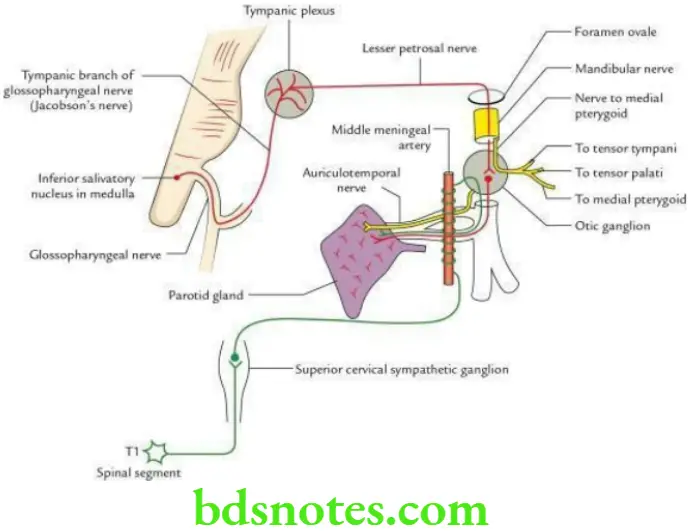
Otic Ganglion Distribution
Parasympathetic (secretomotor) fibres: Supply parotid gland through auriculotemporal nerve.
Sympathetic (vasoconstrictor) fibres: Supply blood vessels of parotid gland through auriculotemporal nerve.
Sensory fibres: Provide sensory innervation to parotid gland through auriculotemporal nerve.
Motor fibres: Supply three muscles through nerve to medial pterygoid – medial pterygoid, tensor palati and tensor tympani.
Question 10. Draw a flowchart to show the secretomotor pathway to the parotid gland.
Answer.
Below is the showing secretomotor pathway to the parotid gland.

Question 11. Describe the maxillary artery under the following headings: (a) origin and extent, (b) parts, (c) branches and (d) applied anatomy.
Answer.
Maxillary Artery Origin and extent
The maxillary artery is the larger of two terminal branches of the external carotid artery. It extends from behind the neck of the mandible to the sphenopalatine foramen, where it continues as the sphenopalatine artery.
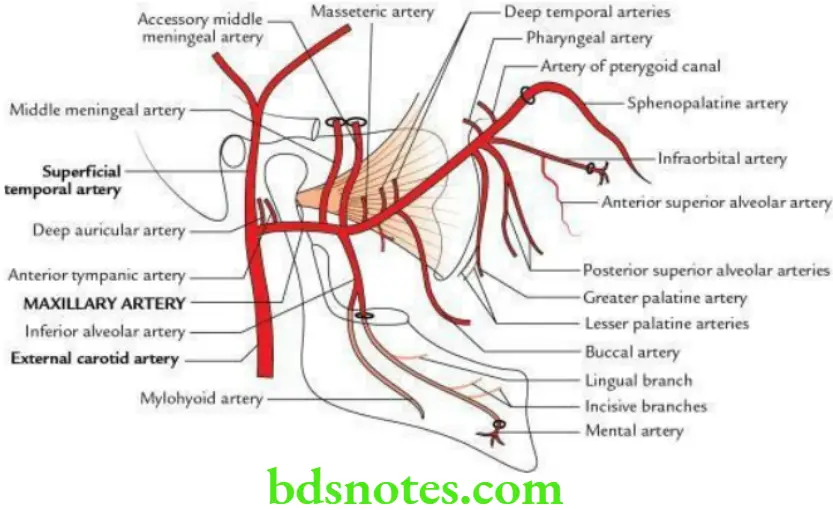
Maxillary Artery Parts
For descriptive purposes, the maxillary artery is divided into three parts by lateral pterygoid (inferior head).
First part: It extends from the neck of the mandible to the point where it crosses the lower border of lateral pterygoid (inferior head).
Second part: It lies superficial or deep to lateral pterygoid.
Third part: It is beyond the upper border of lateral pterygoid. It passes between two heads of lateral pterygoid, passes through pterygomaxillary fissure to enter into pterygopalatine fossa, where it terminates by dividing into sphenopalatine and greater palatine arteries.
Maxillary Artery Branches
From first part:
- Anterior tympanic artery
- Deep auricular artery
- Middle meningeal artery
- Accessory meningeal artery
- Inferior alveolar artery
From second part: Muscular branches to supply temporalis (deep temporal arteries), pterygoids, masseter and buccinator (buccal branch) muscles.
From third part:
- Posterior superior alveolar arteries
- Greater palatine artery
- Infraorbital artery
- Pharyngeal branch
- Artery of pterygoid canal
- Sphenopalatine artery (the continuation of maxillary artery)
Maxillary Artery Applied anatomy
Middle meningeal artery: It often ruptures inside the cranial cavity following a trauma on the lateral aspect of the skull and leads to the formation of extradural haematoma.
Inferior alveolar artery: Sometimes it may rupture during extraction of tooth of the lower jaw leading to osteomyelitis of the lower jaw.
Sphenopalatine artery: Its septal branch (rhinologist’s artery) takes part in the formation of Kiesselbach’s plexus in Little’s area of nose. It is the most common source of nose bleeding.
Question 12. Write a short note on middle meningeal artery.
Answer.
The middle meningeal artery arises from first part of the maxillary artery in the infratemporal fossa deep to lateral pterygoid muscle.
- The artery ascends upwards and enters into middle cranial fossa through foramen spinosum.
- On entering the cranial cavity, it lies in the groove deep to corresponding vein and divides into anterior (frontal) and posterior (parietal) terminal branches.
The larger anterior branch ascends crossing the greater wing of sphenoid in a groove just deep to the pterion of lateral wall of skull. Then it runs obliquely upwards and backwards parallel to and little in front of central sulcus, on precentral gyrus.
- The smaller posterior branch runs backwards over the superior temporal sulcus of cerebrum about 4 cm above the zygomatic arch.
Middle Meningeal Artery Branches
Predominantly, middle meningeal artery is periosteal artery which supplies bone and red marrow within the dipole.
Within the cranial cavity it gives rise to the following branches:
- Anterior branch supplies dura mater and skull bones in the frontal region of skull.
- Posterior branch supplies dura mater and skull bone in the parietal region.
- Ganglionic branches to trigeminal ganglion.
- Petrosal branch enters the hiatus of greater petrosal nerve to supply facial nerve.
- Superior tympanic branch to supply tensor tympani muscle.
- Temporal branches pass through foramina in the greater wing of sphenoid to enter in the temporal fossa.
- Anastomotic branch which anastomoses with the recurrent meningeal branch of lacrimal artery.
Middle Meningeal Artery Applied anatomy
Middle meningeal artery is the commonest source of extradural haemorrhage. Fractures on the lateral side of skull involving pterion tear the middle meningeal artery (anterior branch) producing extradural haematoma lying over premotor area of cerebral cortex. This leads to pressure symptoms, e.g. contralateral hemiplegia. Hence, extradural haematoma is an acute surgical emergency.
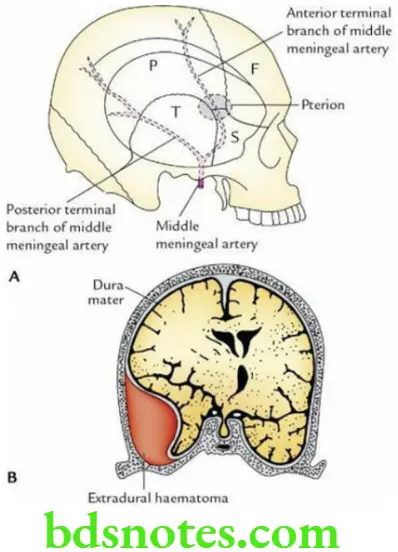
Temporomandibular joint
Question 1. Describe the temporomandibular joint (TMJ) under the following headings: (a) classification, (b) articular surfaces, (c) ligaments, (d) relations, (e) nerve supply, (f) movements and (g) applied anatomy.
Answer.
Temporomandibular Joint Classification
It is synovial joint of condylar variety.
Special features of TMJ:
- It is atypical synovial joint because its articular surfaces are covered by fibrocartilage instead of hyaline cartilage.
- It is a complex synovial joint because its cavity contains an articular disc.
- Two condyles of mandible articulate with a mechanically single bony component, the cranium; hence, two TMJs together function as single unit and form a single craniomandibular joint of bicondylar variety.
Temporomandibular Joint Articular surfaces
Above: Articular fossa and articular tubercle/eminence of temporal bone. It is concavoconvex from behind to forward and is covered by a fibrocartilage.
Below: Head of mandible. It is elliptical and is also covered by a fibrocartilage.
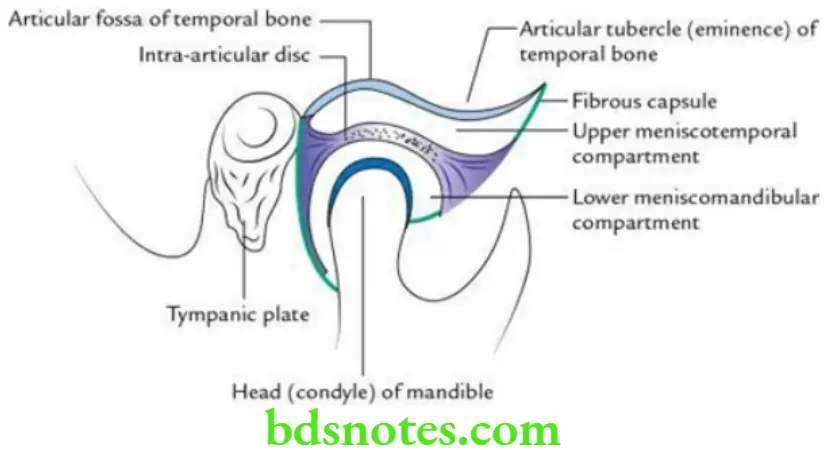
The joint cavity is divided into two parts by an articular disc: (a) upper meniscotemporal compartment that permits gliding movements and (b) lower meniscomandibular compartment that permits rotational as well as gliding movements.
Temporomandibular Joint Ligaments
Temporomandibular Joint Main ligaments
- Capsular ligament: It is attached above to the articular tubercle, the circumference of mandibular fossa and squamotympanic fissure, and below to the neck of mandible.
- Lateral ligament/temporomandibular ligament: It is a thick band of fibrous tissue that covers the lateral aspect of capsule and strengthens it. It extends from articular tubercle on root of zygoma above to the lateral aspect of the neck of mandible below. Its fibres run downwards and backwards.
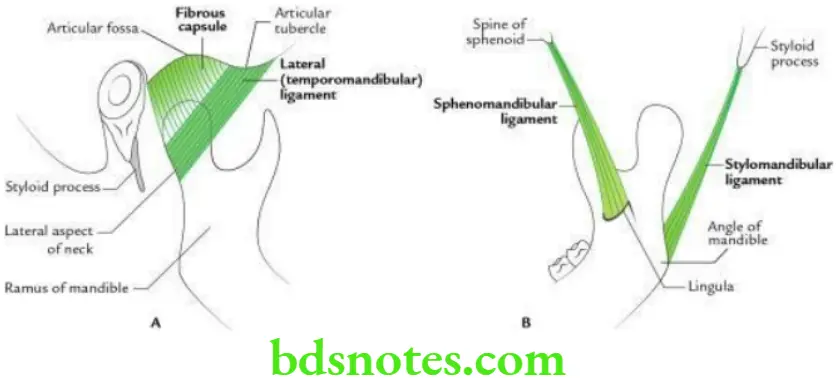
Temporomandibular Joint Accessory ligaments
- Stylomandibular ligament: It extends from styloid process of temporal bone to the angle of mandible. It is formed due to thickening in the investing layer of deep cervical fascia.
- Sphenomandibular ligament: It extends from spine of sphenoid to the lingula of mandible. It is derived from the first pharyngeal arch cartilage.
Temporomandibular Joint Relations
Lateral
- Skin and fasciae
- Parotid gland
- Temporal branches of facial nerve
Medial
- Tympanic plate of temporal bone
- Spine of the sphenoid and sphenomandibular ligament
- Auriculotemporal and chorda tympani nerves
- Middle meningeal artery
Anterior
- Lateral pterygoid
- Masseteric nerve and artery
Posterior
- Parotid gland, which separates the joint from the external auditory meatus
- Superficial temporal vessels
- Auriculotemporal nerve
Superior
- Middle cranial fossa
- Middle meningeal vessels
Inferior
- Maxillary artery and vein
Temporomandibular Joint Nerve supply
- Auriculotemporal nerve
- Masseteric nerve
Temporomandibular Joint Movements
The movements of the temporomandibular joints and muscles producing.
Movements of TMJ and Muscles Producing Them
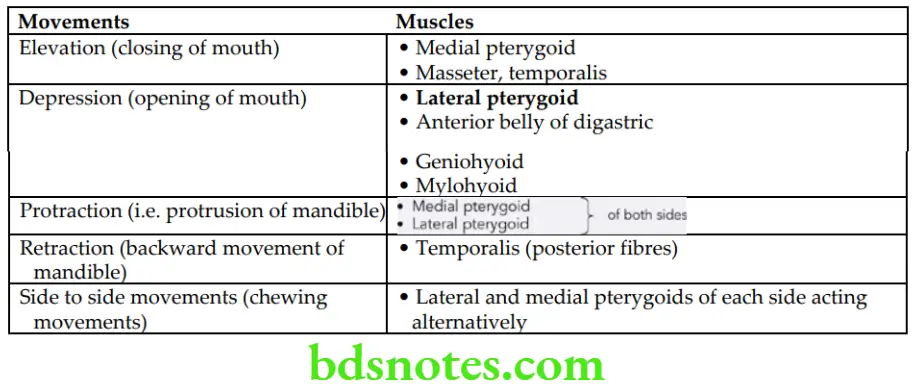
Temporomandibular Joint Applied anatomy
- Dislocation of temporomandibular joints (TMJs): The TMJs are mostly dislocated anteriorly. When the mouth is open, the mandibular condyles lie underneath the articular eminences of the temporal bone (the most unstable position of TMJ). In this position, if mouth is opened widely or even a severe muscular spasm (e.g. a convulsive yawn) it may displace the heads of mandible forward and upwards to be locked into the infratemporal fossa, leading to anterior dislocation of TMJ. As a result, there is inability to open mouth.
The reduction of joint can be easily achieved by pressing the molar teeth downwards with thumbs, and at the same time pushing the chin upward and backward. - Jaw clicking: The articular disc of TMJ may become partially detached from the capsule. As a result, movements of jaw becomes noisy and produces an audible click during movements of the TMJ.
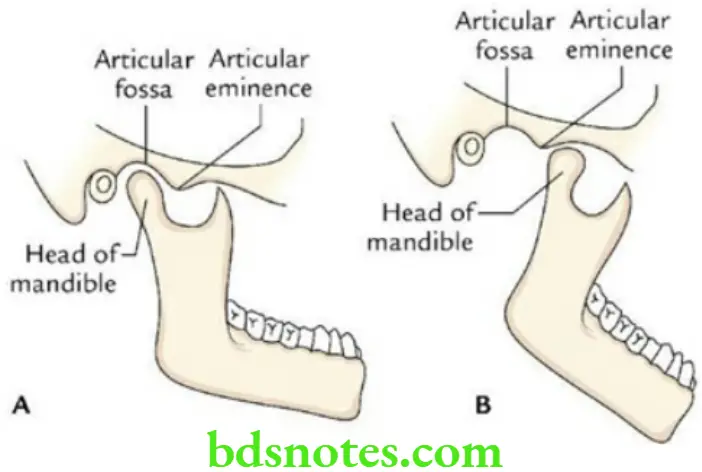
Question 2. Write briefly about articular disc of TMJ.
Answer.
Articular Disc of Temporomandibular Joint General features
- It is an oval plate of fibrocartilage, which divides the cavity TMJ into two compartments: (a) an upper meniscotemporal compartment and (b) a lower meniscomandibular compartment.
- It presents a thick peripheral margin and a thin central part.
- It has concavoconvex superior surface and a concave inferior surface.
- Its periphery is firmly attached to the fibrous capsule.
- Morphologically, it represents the tendon of lateral pterygoid muscle.
Parts of articular disc of Temporomandibular Joint
In sagittal section, it presents five parts. From before to backwards these are:
- Anterior extension
- Anterior thick band
- Intermediate thin part
- Posterior thick band
- Posterior bilaminar extension
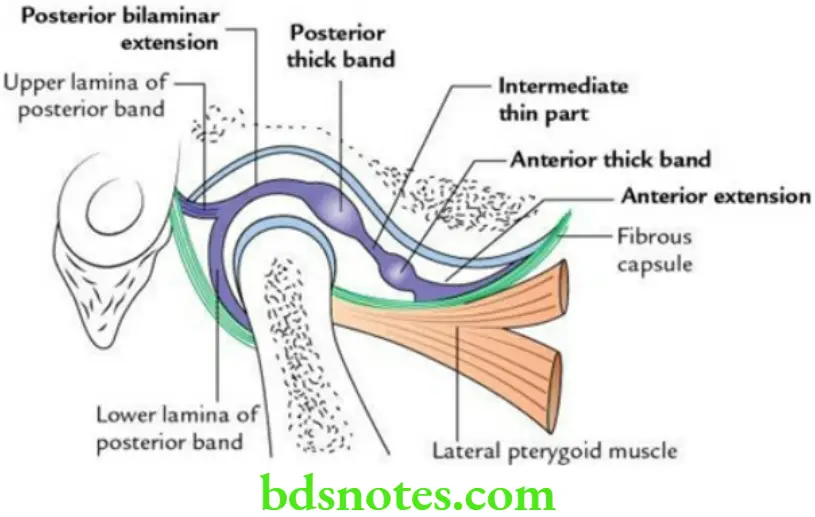

Leave a Reply